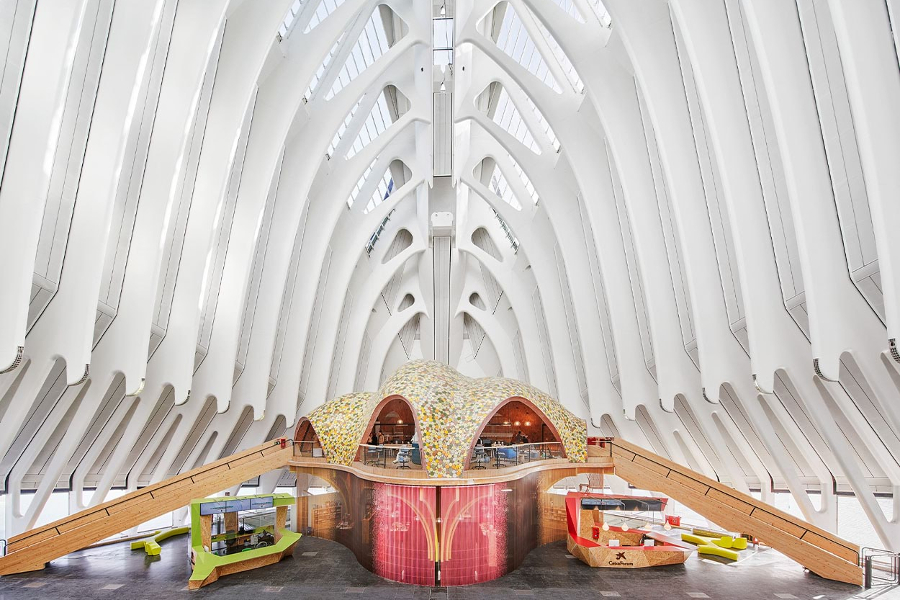In the new exhibition and multifunctional centre, designed by Cloud 9 and located inside this magnificent structure by Santiago Calatrava, an adhesive system by Mapei was employed to create a colourful ceramic covering
“We are inside a whale that needs to stay alive”, said Enric Ruiz-Geli, the architect who brought new life to the structure by Santiago Calatrava, putting the culture of the Mediterranean and sustainability at the centre of the project.
After being unused for around a decade, the Ágora by Santiago Calatrava, inaugurated in November 2009 in the City of Arts and Sciences in Valencia, has been “reborn” thanks to an innovative architectural project commissioned by the La Caixa Foundation with an investment of 19 million euro.
The extraordinary result of the project is the CaixaForum Valencia, a space dedicated to spreading culture in the widest sense of the word (history, art, science and technology) located within a 75 m high metal structure covered with fragments of light blue ceramic, an aspiration of Calatrava to host large numbers of people for various types of events.
As the Director of CaixaForum Valencia, Álvaro Borrás Falomir, declared, “The creation of CaixaForum in Valencia fills a space left empty for more than ten years that we wanted to hand back to the citizens of Valencia. It was that missing piece of the mosaic of the City of Arts and Sciences”.

The new design by Enric Ruiz-Geli and the Cloud 9 design studio conceived the exhibition space, extending over an area of 6.500 m² and surrounded by water, as a living organism inside which various elements can be found. The "cells" of this organism are made up of two exhibition halls, an auditorium with seating for 300 people, a bookshop and a restaurant.
One of the principles behind the project is an appreciation of the concept of agorà, an open space destined to become a meeting place and for cultural initiatives, with particular attention to environmental sustainability. In the words of Enric Ruiz-Geli, “We have created a space inside this fantastic structure by Santiago Calatrava that puts our Mediterranean culture at the centre, combining tradition and innovation”.
So, this is much more than a conventional museum. Apart from being able to visit exhibitions on topics such as history, technology and art, the CaixaForum is also a place where people can listen to concerts, take part in conferences, watch shows and take part in workshops aimed at all age groups.
Since these “cells” are located inside and are protected by the enormous shell of the structure of the building, the architecture of the original building and that of the more recent project coexist harmoniously, encouraging people to enjoy and make use of the spaces. The new project respects, enhances and coexists with the pre-existing building while maintaining its function as a public and dynamic cultural space.
"Paradoxically, the most surprising CaixaForum is the one that is hidden, the one that will least moodify the city in which it is constructed. Maybe it is also the one that will make it dream even more", Anatxu Zabalbescoa, El País.

A specific bonding system for the multicoloured ceramic covering
Apart from the “Cloud”, a hall in shimmering colours indicating the temperature of the oceans to be used for cultural and educational activities, the auditorium where concerts are held and the restaurant with a roof garden, the CaixaForum also has a space used as a bookshop and for the administration offices, whose upper surfaces are completely covered with circular ceramic elements in three different diameters and ten different colours, forming a highly colourful and very original mosaic.

These coverings, the work of the ceramist Toni Cumella, required the use of CAD parametric software and a specific adhesive system to guarantee they would have a sound, long-lasting bond over a structure consisting of fiberglass sheets or chipboard fiberboards.
The system, supplied by the Group’s Spanish subsidiary Mapei Spain, consisted of ULTRABOND ECO PU2K, a two-component, solvent-free polyurethane adhesive with very low emission of volatile organic compounds (VOC), which was chosen for its characteristics such as good workability, excellent durability and perfect adhesion to substrates, as well as being applicable on vertical and sloping surfaces without slumping or allowing the ceramic elements to slip.
This project was one of the finalists for the Premio Mapei a la Arquitectura Sostenible, an initiative with which Mapei Spain promotes and recognises sustainability in architecture and the construction industry.
About the project
Construction period: 2018-2019
Original design: Santiago Calatrava
Year of redevelopment: 2021
Redevelopment design: Enric Ruiz-Geli and Cloud 9
Client: Caixa Foundation
Main contractor: Sorigüé
Design of ceramic coverings: Toni Cumella
Ceramic installation contractor: Cerámica y Fibra S.L.
Mapei coordinators: David Martinez and Joan Lleal, Mapei Spain.







